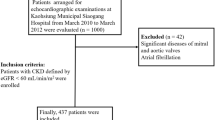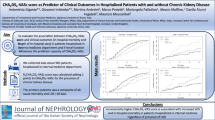Abstract
Background
It is unclear how the CHA2DS2-VASc score can predict subsequent chronic kidney disease (CKD) and end-stage renal disease (ESRD) among atrial fibrillation (AF) patients.
Methods
We identified incident AF patients without CKD between 2000 and 2013 from the National Health Insurance Research Database (NHIRD) of Taiwan and calculated the CHA2DS2-VASc score for each patient. Adjusted hazard ratio (HR) with 95% confidence interval (CI) was estimated from multivariate cause-specific Cox models to assess the risk of CKD and ESRD associated with the CHA2DS2-VASc score.
Results
A total of 8764 participants with AF who did not have CKD were included in the analysis. The mean age was 69.63 ± 13.48 years and 4800 (54.8%) were males. The adjusted HR of CKD displayed a stepwise increase with the increase in the CHA2DS2-VASc score. When compared with those with a CHA2DS2-VASc score of 0, the adjusted HRs of CKD were 1.57 (95% CI 1.09–2.26), 2.04 (95% CI 1.42–2.94), 2.48 (95% CI 1.70–3.62), 2.88 (95% CI 1.95–4.26), 3.29 (95% CI 2.18–4.95) and 4.00 (95% CI 2.61–6.13) for the AF patients with a CHA2DS2-VASc score of 1, 2, 3, 4, 5 and ≥ 6, respectively. Similarly, as the CHA2DS2-VASc score increased, the adjusted HR of ESRD showed a gradual increase.
Conclusions
Patients with a higher CHA2DS2-VASc score were linked to a higher risk of CKD and ESRD in a dose-dependent effect, i.e. the incidence of CKD/ESRD increased with the increasing CHA2DS2-VASc score.




Similar content being viewed by others
References
Camm AJ, Lip GY, De Caterina R, Savelieva I, Atar D, Hohnloser SH, Hindricks G, Kirchhof P, ESC Committee for Practice Guidelines-CPG; Document Reviewers (2012) Focused update of the ESC Guidelines for the management of atrial fibrillation: an update of the 2010 ESC Guidelines for the management of atrial fibrillation–developed with the special contribution of the European Heart Rhythm Association. Europace 14(10):1385–1413
Keller K, Geyer M, Münzel T et al (2019) Impact of atrial fibrillation on in-hospital mortality of ischemic stroke patients and identification of promoting factors of atrial thrombi—results from the German nationwide inpatient sample and a single-center retrospective cohort. Medicine (Baltimore) 98(4):e14086
Paciaroni M, Agnelli G, Ageno W et al (2016) Timing of anticoagulation therapy in patients with acute ischaemic stroke and atrial fibrillation. Thromb Haemost 116(3):410–416
Gage BF, Waterman AD, Shannon W et al (2001) Validation of clinical classification schemes for predicting stroke: results from the National Registry of Atrial Fibrillation. JAMA 285:2864–2870
Olesen JB, Lip GY, Hansen ML et al (2011) Validation of risk stratification schemes for predicting stroke and thromboembolism in patients with atrial fibrillation: nationwide cohort study. BMJ 342:d124
Chao TF, Lin YJ, Tsao HM et al (2011) CHADS(2) and CHA(2)DS(2)-VASc scores in the prediction of clinical outcomes in patients with atrial fibrillation after catheter ablation. J Am Coll Cardiol 58:2380–2385
Chao TF, Liu CJ, Chen SJ et al (2012) Atrial fibrillation and the risk of ischemic stroke: does it still matter in patients with a CHA2DS2-VASc score of 0 or 1? Stroke 43:2551–2555
Levey AS, Inker LA, Coresh J (2015) Chronic kidney disease in older people. JAMA 314(6):557–558
Bansal N, Xie D, Tao K, Chen J, Deo R, Horwitz E, Hsu CY, Kallem RK, Keane MG, Lora CM, Raj D, Soliman EZ, Strauss WM, Go AS, CRIC Study (2016) Atrial fibrillation and risk of ESRD in adults with CKD. Clin J Am Soc Nephrol. 11(7):1189–1196
Massicotte-Azarniouch D, Kuwornu JP, Carrero JJ et al (2018) Incident atrial fibrillation and the risk of congestive heart failure, myocardial infarction, end-stage kidney disease, and mortality among patients with a decreased estimated GFR. Am J Kidney Dis 71(2):191–199
Bansal N, Fan D, Hsu CY, Ordonez JD, Marcus GM, Go AS (2013) Incident atrial fibrillation and risk of end-stage renal disease in adults with chronic kidney disease. Circulation 127:569–574
Bukowska C, Rocken M, Erxleben FW, Rohl M, Hammwohner CH et al (2010) Atrial expression of endothelial nitric oxide synthase in patients with and without atrial fibrillation. Cardiovasc. Pathol 19(3):e51–60
Goette A, Hammwohner M, Bukowska A, Scalera F, Martens-Lobenhoffer J, Dobrev D et al (2012) The impact of rapid atrial pacing on ADMA and endothelial NOS. Int J Cardiol 154(2):141–146
Olesen JB, Lip GY, Kamper AL, Hommel K, Køber L, Lane DA, Lindhardsen J, Gislason GH, Torp-Pedersen C (2012) Stroke and bleeding in atrial fibrillation with chronic kidney disease. N Engl J Med 367(7):625–635
Melgaard L, Gorst-Rasmussen A, Lane DA, Rasmussen LH, Larsen TB, Lip GY (2015) Assessment of the CHA2DS2-VASc score in predicting ischemic stroke, thromboembolism, and death in patients with heart failure with and without atrial fibrillation. JAMA 314(10):1030–1038
Cetin M, Cakici M, Zencir C, Tasolar H, Baysal E, Balli M, Akturk E (2014) Prediction of coronary artery disease severity using CHADS2 and CHA2DS2-VASc scores and a newly defined CHA2DS2-VASc-HS score. Am J Cardiol 113(6):950–956
Perini P, Bartolini S, Pieragnoli P, Ricciardi G, Perrotta L, Valleggi A, Vergaro G, Michelotti F, Boggian G, Sassone B, Mascioli G, Emdin M, Padeletti L (2014) CHADS2 and CHA2DS2-VASc scores to predict morbidity and mortality in heart failure patients candidates to cardiac resynchronization therapy. Europace 16(1):71–80
Wu PP, Kor CT, Hsieh MC, Hsieh YP (2018) Association between end-stage renal disease and incident Diabetes Mellitus—a nationwide population-based cohort study. J Clin Med 7(10)
Yang CT, Kor CT, Hsieh YP (2018) Long-term effects of spironolactone on kidney function and hyperkalemia-associated hospitalization in patients with chronic kidney disease. J Clin Med 7(11)
Banerjee A, Allan V, Denaxas S et al (2019) Subtypes of atrial fibrillation with concomitant valvular heart disease derived from electronic health records: phenotypes, population prevalence, trends and prognosis. Europace. https://doi.org/10.1093/europace/euz220(Epub ahead of print)
Bohm M, Ezekowitz MD, Connolly SJ, Eikelboom JW, Hohnloser SH, Reilly PA et al (2015) Changes in renal function in patients with atrial fibrillation: an analysis from the RE-LY trial. J Am Coll Cardiol 65(23):2481–2493
Beyer-Westendorf J, Kreutz R, Posch F, Ay C (2018) The CHA2DS2-VASc score strongly correlates with glomerular filtration rate and predicts renal function decline over time in elderly patients with atrial fibrillation and chronic kidney disease. Int J Cardiol 253:71–77
Collister D, Ferguson T, Komenda P, Tangri N (2016) The patterns, risk factors, and prediction of progression in chronic kidney disease: a narrative review. Semin Nephrol 36(4):273–282
Rajapurkar MM, John GT, Kirpalani AL et al (2012) What do we know about chronic kidney disease in India: first report of the Indian CKD Registry. BMC Nephrol 13:10
Shaw JE, Sicree RA, Zimmet PZ (2010) Global estimates of the prevalence of diabetes for 2010 and 2030. Diabetes Res Clin Pract 87:4–14
Kearney PM, Whelton M, Reynolds K et al (2005) Global burden of hypertension: analysis of worldwide data. Lancet 365:217–223
Chwojnicki K, Król E, Wierucki Ł, Kozera G, Sobolewski P, Nyka WM, Zdrojewski T (2016) Renal dysfunction in post-stroke patients. PLoS ONE 11(8):e0159775
Shimizu M, Furusyo N, Mitsumoto F, Takayama K, Ura K, Hiramine S, Ikezaki H, Ihara T, Mukae H, Ogawa E, Toyoda K, Kainuma M, Murata M, Hayashi J (2015) Subclinical carotid atherosclerosis and triglycerides predict the incidence of chronic kidney disease in the Japanese general population: results from the Kyushu and Okinawa Population Study (KOPS). Atherosclerosis 238(2):207–212
Pang Y, Sang Y, Ballew SH, Grams ME, Heiss G, Coresh J, Matsushita K (2016) Carotid intima-media thickness and incident ESRD: the atherosclerosis risk in communities (ARIC) study. Clin J Am Soc Nephrol 11(7):1197–1205
Hoogeveen EK, Geleijnse JM, Kromhout D, Stijnen T, Gemen EF, Kusters R, Giltay EJ (2014) Effect of omega-3 fatty acids on kidney function after myocardial infarction: the Alpha Omega trial. Clin J Am Soc Nephrol 9(10):1676–1683
Yu MK, Katon W, Young BA (2015) Associations between sex and incident chronic kidney disease in a prospective diabetic cohort. Nephrology (Carlton) 20(7):451–458
Hsu PK, Kor CT, Hsieh YP (2018) Effect of new-onset Diabetes Mellitus on renal outcomes and mortality in patients with chronic kidney disease. J Clin Med 7(12)
Funding
This study was funded by Grants 106-CCH-IRP-029, 107-CCH-HCR-033 and 108-CCH-IRP-092 from the Changhua Christian Hospital Research Foundation. The funding sources had no role in the design or conduct or reporting of the study.
Author information
Authors and Affiliations
Contributions
All authors listed have contributed sufficiently to the project to be included as authors and all those who are qualified to be authors are listed in the author by line. C-JW conceived and designed the experiments. C-TK analyzed the data. Y-PH wrote the original draft. P-FC reviewed and edited the paper.
Corresponding authors
Ethics declarations
Conflict of interest
There is no conflicts of interest.
Ethical approval
All procedures performed in studies involving human participants were in accordance with the ethical standards of the institutional and/or national research committee and with the 1964 Helsinki declaration and its later amendments or comparable ethical standards.
Additional information
Publisher's Note
Springer Nature remains neutral with regard to jurisdictional claims in published maps and institutional affiliations.
Electronic supplementary material
Below is the link to the electronic supplementary material.
11255_2020_2514_MOESM1_ESM.tif
Supplementary Figure 1. Cumulative incidence curves of chronic kidney disease in patients with different CHA2DS2-VASc scores (log-rank test, p<0.001). (TIF 919 kb)
11255_2020_2514_MOESM2_ESM.tif
Supplementary Figure 2. Cumulative incidence curves of end-stage renal disease in patients with different CHA2DS2-VASc scores (log-rank test, p<0.001). Supplementary file2 (TIF 919 kb)
11255_2020_2514_MOESM3_ESM.docx
Supplementary Table 1. ICD-9-CM codes used to identify atrial fibrillation, chronic kidney disease, end-stage renal disease and other comorbidities. (DOCX 17 kb)
Rights and permissions
About this article
Cite this article
Wang, CJ., Hsieh, YP., Kor, CT. et al. The CHA2DS2-VASc score predicts chronic kidney disease among patients with atrial fibrillation. Int Urol Nephrol 52, 1523–1531 (2020). https://doi.org/10.1007/s11255-020-02514-x
Received:
Accepted:
Published:
Issue Date:
DOI: https://doi.org/10.1007/s11255-020-02514-x




